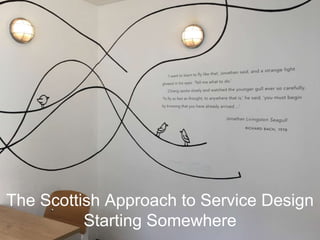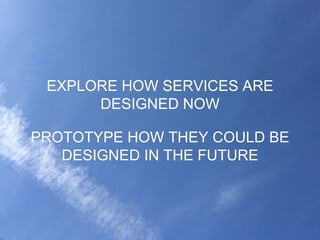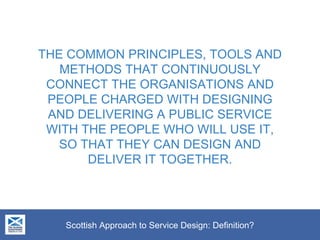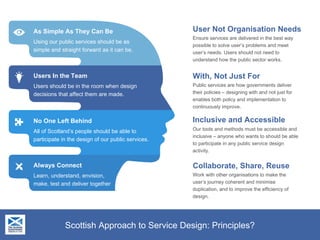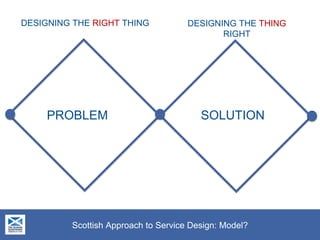Scottish Approach to Service Design introductory slides
- 1. The Scottish Approach to Service Design Starting Somewhere
- 3. EXPLORE HOW SERVICES ARE DESIGNED NOW PROTOTYPE HOW THEY COULD BE DESIGNED IN THE FUTURE
- 8. THE VISION
- 10. Scottish Approach to Service Design: Definition? THE COMMON PRINCIPLES, TOOLS AND METHODS THAT CONTINUOUSLY CONNECT THE ORGANISATIONS AND PEOPLE CHARGED WITH DESIGNING AND DELIVERING A PUBLIC SERVICE WITH THE PEOPLE WHO WILL USE IT, SO THAT THEY CAN DESIGN AND DELIVER IT TOGETHER.
- 11. Public Service Reform SCOTTISH PROGRAMME FOR GOVERNMENT 2015/16 This is a collective endeavour (…) We believe that by involving and engaging citizens and communities in the design and delivery of services, by removing barriers where we come across them, and by working more collaboratively within and across public service boundaries, we will deliver the change needed.
- 12. Scottish Approach to Service Design: Principles? Using our public services should be as simple and straight forward as it can be. As Simple As They Can Be Users should be in the room when design decisions that affect them are made. Users In the Team All of Scotland’s people should be able to participate in the design of our public services. No One Left Behind Learn, understand, envision, make, test and deliver together Always Connect User Not Organisation Needs Ensure services are delivered in the best way possible to solve user’s problems and meet user’s needs. Users should not need to understand how the public sector works. Collaborate, Share, Reuse Work with other organisations to make the user’s journey coherent and minimise duplication, and to improve the efficiency of design. Inclusive and Accessible Our tools and methods must be accessible and inclusive – anyone who wants to should be able to participate in any public service design activity. With, Not Just For Public services are how governments deliver their policies – designing with and not just for enables both policy and implementation to continuously improve.
- 13. We need more people with user research and design skills – how will we get them? (Sustainable) Capacity Without them public service wide sharing, reuse and collaboration are impossible. Common Tools and Methods How do we help citizens participate in design in inclusive and meaningful ways? Capabilities How do we build user focussed service design into the DNA of orgs designing public services. Culture Change
- 15. Scottish Approach to Service Design: Model? DESIGNING THE RIGHT THING DESIGNING THE THING RIGHT PROBLEM SOLUTION

